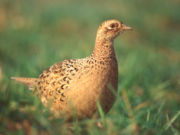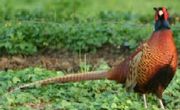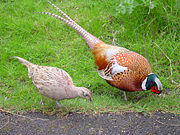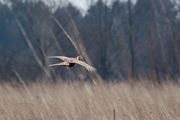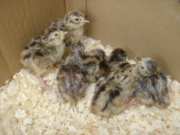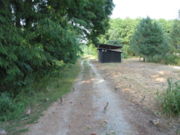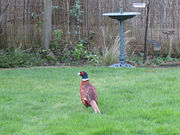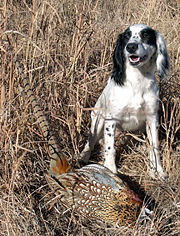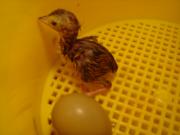Common Pheasant
2008/9 Schools Wikipedia Selection. Related subjects: Birds; Food
| Common Pheasant | ||||||||||||||||||||
|---|---|---|---|---|---|---|---|---|---|---|---|---|---|---|---|---|---|---|---|---|
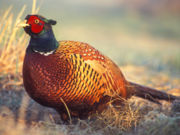 Adult male of hybrid stock, Poland Note thin white neck-band due to a ring-necked subspecies' contribution to hybrid gene pool 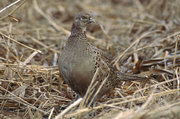 Adult hen, Poland
|
||||||||||||||||||||
| Conservation status | ||||||||||||||||||||
| Scientific classification | ||||||||||||||||||||
|
||||||||||||||||||||
| Binomial name | ||||||||||||||||||||
| Phasianus colchicus Linnaeus, 1758 |
The Common Pheasant (Phasianus colchicus), is a bird in the pheasant family (Phasianidae). It is native to Asia but has been widely introduced elsewhere as a game bird. In parts of its range, namely in places where none of its relatives occur such as in Europe (where it is naturalized), it is simply known as "the pheasant". It is a well-known gamebird, among those of more than regional importance perhaps the most widespread and ancient one in the whole world.
The Common Pheasant is one of the world's most hunted birds, has it has been introduced for that purpose to many regions, and is also common on game farms where it is commercially farmed for this purpose. "Ring-necked Pheasant" is a collective name for a number of subspecies and their crossbreeds. These were commonly used for introduction purposes, and today the Ring-necked Pheasant is the state bird of South Dakota, one of only three US state birds that is not a species native to the United States.
The Green Pheasant (P. versicolor) of Japan is sometimes placed as subspecies within the Common Pheasant. Though the species produce fertile hybrids wherever they coexist, this is simply a typical feature among Galloanseres, in which postzygotic isolating mechanisms are slight compared to most other birds. The species apparently have somewhat different ecological requirements and at least in its typical habitat the Green outcompetes the Common Pheasant; introduction of the present species to Japan has therefore largely failed.
Description
There are many colour forms of the male Common Pheasant, ranging in colour from nearly white to almost black in some melanistic examples. These are due to captive breeding and hybridization between subspecies and with the Green Pheasant, reinforced by continually releases of stock from varying souces to the wild. For example, the "Ring-necked Pheasants" common in Europe, North America and Australia do not pertain to any specific taxon, they rather represent a stereotyped hybrid swarm.
The adult male Common Pheasant of the nominate subspecies Phasianus colchicus colchicus is 76-89 cm in length with a long brown streaked black tail, accounting for almost 50 cm of the total length. The body plumage is barred bright gold and brown plumage with green, purple and white markings. The head is bottle green with a small crest and distinctive red wattles. P. c. colchicus and some other races lack a white neck ring.
The female (hen) is much less showy, with a duller mottled brown plumage all over and measuring 53-63 cm long including a tail of around 20 cm. Juvenile birds have the appearance of the female with a shorter tail until young males begin to grow characteristic bright feathers on the breast, head and back at about 10 weeks after hatching.
The Green Pheasant (P. versicolor) is very similar, and hybridizaton makes individual birds' identities often difficult to determine. Green Pheasant males are shorter-tailed on average and have a darker plumage that is uniformly bottle-green on the breast and belly; they always lack a neck ring. Their females are darker, with many black dots on the breast and belly.
In addition, various colour mutations are commonly encoutered, mainly melanistic (black) and flavistic ( isabelline or fawn) specimens. The former are rather common in some areas and are named Tenebrosus Pheasant (P. colchicus var. tenebrosus).
Taxonomy and systematics
This species was first scientifically described by Linnaeus in his Systema naturae in 1758 under its current scientific name. The Common Pheasant is distinct enough from any other species known to Linnaeus for a laconic [Phasianus] rufus, capîte caeruleo - "a red pheasant with blue head" - to serve as entirely sufficient description. Moreover, the bird had been extensively discussed before Linnaeus established binomial nomenclature. His sources are the Ornithologia of Ulisse Aldrovandi, Giovanni Pietro Olina's Uccelliera, John Ray's Synopsis methodica Avium & Piscium, and A natural history of the birds by Eleazar Albin. In these - essentially the bulk of the ornithology textbooks of his day - the species is simply named "the pheasant" in the books' respective languages.. The type locality is given simply as "Africa, Asia".
However, the bird does not occur in Africa, except perhaps in Linnaeus' time in Mediterranean coastal areas where they might have been introduced during the Roman Empire. The type locality was later fixed to the Rioni River where the westernmost population occurs. This, until the Modern Era, constituted the bulk of the introduced stock in Europe; the birds described by Linnaeus' sources, though typically belonging to such early introductions, would certainly have more alleles in common with the transcaucasian population than with others. The scientific name means "Pheasant from Colchis", colchicus referring to that region in the Caucasus. Although Linnaeus included many Galliformes in his genus Phasianius - such as the domestic chicken and its wild ancestor the Red Junglefowl -, today only the Common and the Green Pheasant are placed in this genus. As the latter was not known to Linnaeus in 1758, the Common Pheasant is naturally the type species of Phasianus, and this genus
In the USA, Common Pheasants are widely known as " Chinese Pheasants" - though they are not the only pheasant species from China, nor the only Chinese pheasant that was attempted to introduce to North America, it is the only such bird that is common and widespread nowadays. More colloquial North American names include " chinks" or, in Montana, "phezzens". In China, meanwhile, the species is properly called zhi ji ( 雉鸡) - "pheasant-fowl" -, essentially implying the same as the English name "Common Pheasant". Like elsewhere, P. colchicus is such a familiar bird in China that it is usually just referred to as shan ji (山雞), "mountain chicken", a Chinese term for pheasants in general.
Subspecies
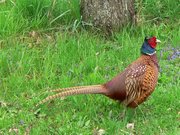
There are about 30 subspecies in five (sometimes six) groups. These can be identified according to the male plumage, namely presence or absence of a white neck-ring and the colour of the uppertail (rump) and wing coverts. As noted above, introduced population in our time mix the alleles of various races in various amounts, differing according to the original stock used for introductions and what natural selection according to climate and habitat has made of that.
Sometimes this species is split into the Central Asian Common and the East Asian Ring-necked Pheasants, roughly separated by the arid and high mountainous regions of Turkestan. However, while the western and eastern populations probably were entirely separate during the Zyryanka glaciation when deserts were more extensive, this separation was not long enough for actual speciation to occur. Today, there is the largest variety of colour patterns where the western and eastern populations mix, as is to be expected. Females usually cannot be identified even to subspecies group with certainty.
The subspecies groups, going from west to east, are:
- Phasianus colchicus colchicus group – Caucasus Pheasants
- Caucasus to W Turkestan.
- No neck ring. Wing coverts buff to brown, uppertail coverts rusty to chestnut.
- Phasianus colchicus chrysomelas/principalis group – White-winged Pheasants including Prince of Wales Pheasant (P. c. principalis)
- Central Turkestan.
- No or vestigial neck ring. Wing coverts white, uppertail coverts and general plumage hue bronze to brown.
- Phasianus colchicus mongolicus group – Mongolian Ring-necked Pheasants or White-winged Ring-necked Pheasants
- NE Turkestan and adjacent Mongolia.
- Broad neck ring. Wing coverts white, uppertail coverts hue rusty to chestnut, general plumage hue copper.
- Phasianus colchicus tarimensis group – Tarim Pheasants
- SE Turkestan around the Tarim Basin.
- No or vestigial neck ring. Wing coverts buff to brown, uppertail coverts dark khaki to light olive.
- Phasianus colchicus torquatus group – Chinese Ring-necked Pheasants including Taiwan Pheasant (P. c. formosanus)
- Throughout China but widespread in the east, extending to northernmost Vietnam and Taiwan in the south and to the Strait of Tartary region in the north.
- Usually broad neck ring. Wing coverts tan to light grey (almost white in some), uppertail coverts grey to powder blue with orange tips. Top of head light grey.
Ecology
Common Pheasants are native to Asia, their original range extending from between the Black and Caspian Seas to Manchuria, Siberia, Korea, Mainland China and Taiwan. The birds are found in woodland, farmland, scrub and wetlands.. In its natural habitat the Common Pheasant lives in grassland near water with small copses of trees. Extensively cleared farmland is marginal habitat that cannot maintain self-sustaining populations for long.
Common Pheasants are gregarious birds and outside the breeding season form loose flocks. Wherever they are hunted they are always timid once they associate humans with danger, and will quickly retreat for safety after hearing hunting teams arrive in the area.
While Common Pheasants are able short-distance fliers, they prefer to run. If startled however, they can suddenly burst upwards at great speed, with a distinctive "whirring" wing sound and often giving kok kok kok calls to alert conspecifics. Their flight speed is only 43-61 kilometres per hour (27 to 38 mph) when cruising but when chased they can fly up to 90 kilometres per hour (60 mph).
Common Pheasants feed solely on the ground but roost in sheltered trees at night. They eat a wide variety of animal and vegetable type-food, like fruit, seeds and leaves as well as a wide range of invertebrates, with small vertebrates like snakes, lizards, small mammals and birds occasionally taken.
The males are polygynous as is typical for many Phasianidae, and are often accompanied by a harem of several females. Common Pheasants nest on the ground, producing a clutch of around ten eggs over a two-three week period in April to June. The incubation period is about 23-26 days. The chicks stay near the hen for several weeks after hatching but grow quickly, resembling adults by only 15 weeks of age.
As introduced species
Common Pheasants can now be found across the globe due to their readiness to breed in captivity and the fact they can naturalise in many climates. Pheasants were hunted in their natural range by Stone Age humans just like the grouse, partridges, junglefowls and perhaps peacocks that inhabited Europe at that time. At least since the Roman Empire the bird was extensively introduced in many places and has become a naturalized member at least of the European fauna. Introductions in the Southern Hemisphere have mostly failed, except where local Galliformes or their ecological equivalents are rare or absent.
The bird was naturalized in Great Britain around the 10th century AD, arguably earlier, by both the Romano-British and the Normans, but became extirpated from most of the isles in the early 17th century. It was rediscovered as a gamebird after being ignored for many years in the 1830s, since when it has been reared extensively by gamekeepers. Because around 30 million pheasants are released each year on shooting estates, it is widespread in distribution, although most released birds survive less than a year in the wild. As the original Caucasian stock all but disappeared during the Early Modern era, most dark-winged ringless birds in the UK are actually descended from Chinese Ringneck and Green Pheasant hybrids which were commonly used for rewilding.
Common Pheasants were introduced in North America in 1857, and have become well established throughout much of the Midwest, the Plains states, and parts of the West, as well as Canada and Mexico. It is now most common on the Great Plains. Common Pheasants have also been introduced to much of north-west Europe, the Hawaiian Islands, Chile, St Helena, Tasmania, New Zealand and Rottnest Island off Australia. It has also been unsuccessfully introduced to many other countries.
Common Pheasants as gamebirds
Common Pheasants are bred to be hunted and are shot in great numbers in Europe, especially the UK, where they are shot on the traditional formal "driven shoot" principles, whereby paying guns have birds driven over them by beaters, and on smaller "rough shoots". The open season in the UK is 1 October - 1 February, under the Game Act 1831. Generally they are shot by hunters employing gun dog to help find, flush, and retrieve shot birds. Retrievers, spaniels, and pointing breeds are used to hunt pheasants.
The doggerel "Up gets a guinea, bang goes a penny-halfpenny, and down comes a half a crown" reflects the expensive sport of nineteenth century driven shoots in Britain, when pheasants were often shot for sport rather than as food. It was a popular Royal pastime in Britain to shoot Common Pheasants. King George V shot over a thousand pheasants out of a total bag of 3937 over a six day period in December 1913, a total which still stands as the British record bag.
Common Pheasants are traditionally a target of small game poachers in the UK, but due to low value of pheasants in the modern day some have resorted to stealing chicks or poults from pens. The Roald Dahl novel Danny the Champion of the World dealt with a poacher (and his son) who lived in the United Kingdom and illegally hunted Common Pheasants.
Pheasant farming is a common practice, and is sometimes done intensively. Birds are supplied both to hunting preserves/estates and restaurants, with smaller numbers being available for home cooks. Pheasant farms have some 10 million birds in the U.S. and 35 million in the United Kingdom.
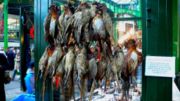
The carcasses were often hung for a time to improve the meat by slight decomposition, as with most other game. Modern cookery generally uses moist roasting and farm-raised female birds. In the UK, game is making somewhat of a comeback in popular cooking, and more pheasants than ever are being sold in UK supermarkets.
Pheasant hunting in North America
Most Common Pheasants bagged in the United States are wild-born feral pheasants; in some states captive-reared and released birds make up much of the population
In many parts of the United States the Pheasant is seen as the premier upland game bird. Some states derive significant revenue from pheasant hunting. In most states only roosters can be legally hunted.
